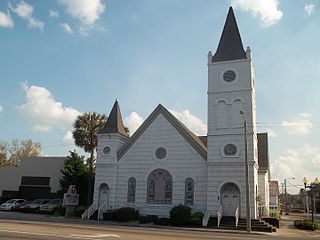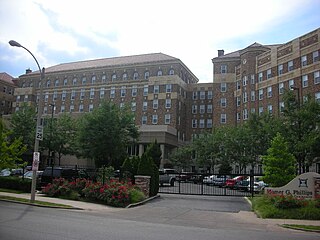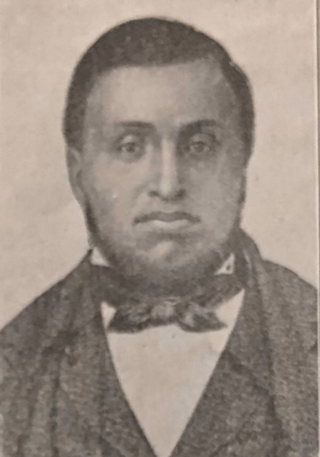
Missouri is a landlocked state in the Midwestern region of the United States. Ranking 21st in land area, it borders Iowa to the north, Illinois, Kentucky and Tennessee to the east, Arkansas to the south and Oklahoma, Kansas, and Nebraska to the west. In the south are the Ozarks, a forested highland, providing timber, minerals, and recreation. The Missouri River, after which the state is named, flows through the center and into the Mississippi River, which makes up the eastern border. With over six million residents, it is the 18th-most populous state of the country. The largest urban areas are St. Louis, Kansas City, Springfield, and Columbia; the capital is Jefferson City.

Ste. Genevieve is a city in Ste. Genevieve Township and is the county seat of Ste. Genevieve County, Missouri, United States. The population was 4,999 at the 2020 census. Founded in 1735 by French Canadian colonists and settlers from east of the river, it was the first organized European settlement west of the Mississippi River in present-day Missouri. Today, it is home to Ste. Genevieve National Historical Park, the 422nd unit of the National Park Service.

The history of Missouri begins with settlement of the region by indigenous people during the Paleo-Indian period beginning in about 12,000 BC. Subsequent periods of native life emerged until the 17th century. New France set up small settlements, and in 1803, Napoleonic France sold the area to the U.S. as part of the Louisiana Purchase. Statehood for Missouri came following the Missouri Compromise in 1820 that allowed slavery. Settlement was rapid after 1820, aided by a network of rivers navigable by steamboats, centered in the City of St. Louis. It attracted European immigrants, especially Germans; the business community had a large Yankee element as well. The Civil War saw numerous small battles and control by the Union. After the war, its economy diversified, and railroads centered in Kansas City, opened up new farmlands in the west.

Bellefontaine Cemetery is a nonprofit, non-denominational cemetery and arboretum in St. Louis, Missouri. Founded in 1849 as a rural cemetery, Bellefontaine has several architecturally significant monuments and mausoleums such as the Louis Sullivan-designed Wainwright Tomb, which is listed on the National Register of Historic Places.

Little Dixie is a historic 13- to 17-county region along the Missouri River in central Missouri, United States. Its early Anglo-American settlers were largely migrants from the hemp and tobacco districts of Virginia, Kentucky, and Tennessee. They brought enslaved African Americans with them or purchased them as workers in the region. Because Southerners settled there first, the pre-Civil War culture of the region was similar to that of the Upper South. The area was also known as Boonslick country.

John Mason Peck (1789–1858) was an American Baptist missionary to the western frontier of the United States, especially in Missouri and Illinois. A prominent anti-slavery advocate of his day, Peck also founded many educational institutions and wrote prolifically.

The black church is the faith and body of Christian denominations and congregations in the United States that predominantly minister to, and are also led by African Americans, as well as these churches' collective traditions and members. The term "black church" may also refer to individual congregations, including in traditionally white-led denominations.

The Ville is a historic African-American neighborhood with many African-American businesses located in North St. Louis, Missouri, U.S.. This neighborhood is a forty-two-square-block bounded by St. Louis Avenue on the north, Martin Luther King Drive on the south, Sarah on the east and Taylor on the west. From 1911 to 1950, The Ville was the center of African American culture within the city of St. Louis.
The American Baptist Home Mission Society is a Christian missionary society. Its main predecessor the Home Mission Society was established in New York City in 1832 to operate in the American frontier, with the stated mission "to preach the Gospel, establish churches and give support and ministry to the unchurched and destitute." In the 19th century, the Society was related to the Triennial Convention of Baptists. Today it is part of that Convention's successor, the American Baptist Churches, USA, and is the successor by merger of several 19th century Baptist organizations related to missions and education, including publications (1824), women (1877), and education (1888)
Charles Felix Van Quickenborne, SJ (1788–1837) was a Belgian Jesuit born best known as a missionary and a founder of St. Louis University. He served as novice master of the Jesuit novitiate at White Marsh, Maryland, and later when it was moved to St. Thomas Manor in Charles County. His missionary work took him to the areas of Missouri, Kansas, and Iowa.

The history of St. Louis, Missouri from 1804 to 1865 included the creation of St. Louis as the territorial capital of the Louisiana Territory, a brief period of growth until the Panic of 1819 and subsequent depression, rapid diversification of industry after the introduction of the steamboat and the return of prosperity, and rising tensions about the issues of immigration and slavery. St. Louis also played a role in the American Civil War.

John Berry Meachum was an American pastor, businessman, educator and founder of the First African Baptist Church in St. Louis, the oldest black church west of the Mississippi River. At a time when it was illegal in the city to teach people of color to read and write, Meachum operated a school in the church's basement. Meachum also circumvented a Missouri state law banning education for black people by creating the Floating Freedom School on a steamboat on the Mississippi River.

James Milton Turner was a Reconstruction Era political leader, activist, educator, and diplomat. Appointed consul general to Liberia in 1871, he was the first African-American to serve in the U.S. diplomatic corps.

Jesse Freeman Boulden was a Baptist pastor and politician in Chicago and Mississippi. He founded churches including Olivet Baptist Church in Chicago. He served in the Mississippi House of Representatives during the Reconstruction Era. He also helped manage the Senate campaigns of Hiram Rhodes Revels and Blanche Kelso Bruce.

The Griot Museum of Black History is a wax museum in St. Louis, Missouri, founded in 1997. Originally named The Black World History Wax Museum, the organization changed its name to The Griot Museum of Black History in 2009. In some west African countries, the griot, is a historian, storyteller, praise singer, poet and/or musician. The griot is a repository of oral tradition and is often seen as a societal leader who preserves and shares cultural traditions of a community. Likewise, the museum collects, preserves, and shares the stories, culture, and history of Black people with a focus on those with a regional connection to St. Louis.

John R. Anderson, also known as J. Richard Anderson, was an American minister from St. Louis, Missouri, who fought against slavery and for education for African Americans. As a boy, he was an indentured servant, who attained his freedom at the age of 12. Anderson worked as a typesetter for the Missouri Republican and for Elijah Parish Lovejoy's anti-slavery newspaper, the Alton Observer. He founded the Antioch Baptist Church in Brooklyn, Illinois and then returned to St. Louis where he was a co-founder and the second pastor of the Central Baptist Church. He served the church until his death in 1863.

The Floating Freedom School was an educational facility for free and enslaved African Americans on a steamboat on the Mississippi River. It was established in 1847 by the Baptist minister John Berry Meachum. After Meachum's death in 1854, the Freedom School was taken over by Reverend John R. Anderson, a former student, and closed sometime after 1860.
Paul and Susannah Mitchem were a couple from Virginia who owned dozens of slaves; late in their life they decided to bring their slaves to Harrison County, Indiana and free them. They also used the Meachum surname. The Mitchems emancipated over 100 enslaved people in Indiana, most of whom settled around Corydon, Indiana. Farms, businesses, churches, and schools were established by and for the African American community, often called the Mitchem Settlement.















